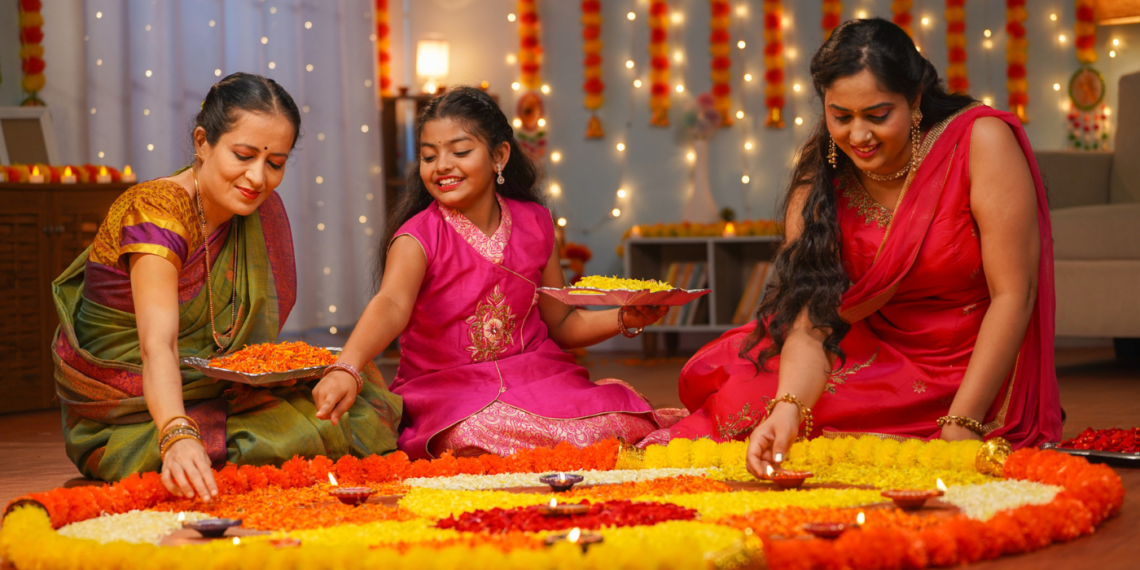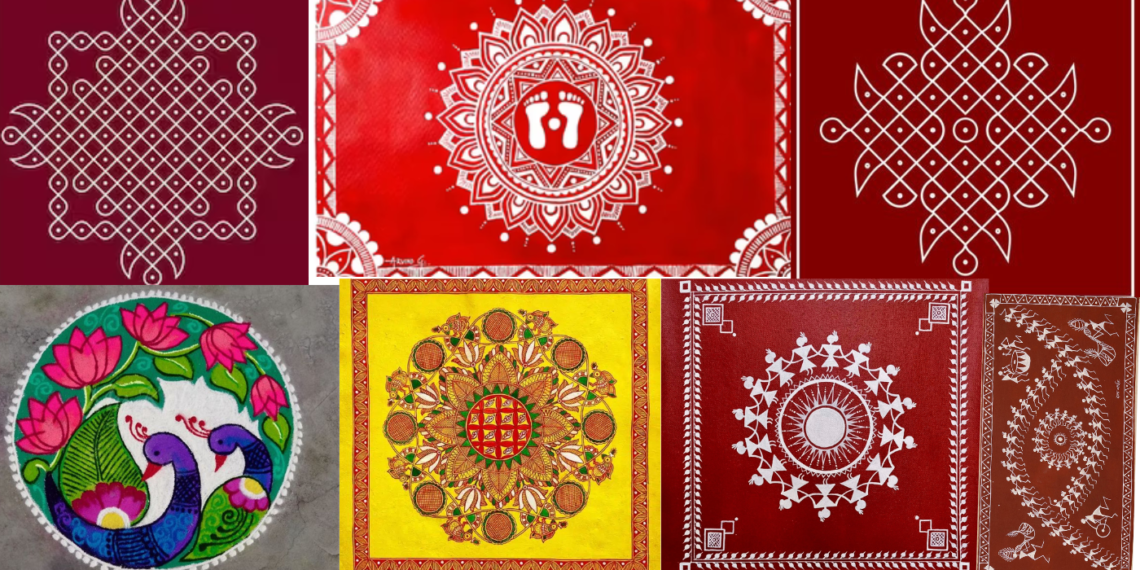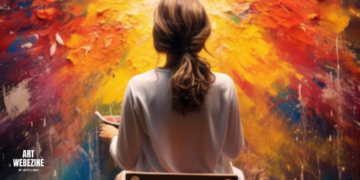Traditional Rangoli Designs, a timeless and captivating art form, have been gracing the entrances of homes and public spaces across India for generations. These intricate and colorful patterns, meticulously created on the ground, serve as a symbol of hospitality, spirituality, and artistic expression. In this journey through the world of Traditional Rangoli Designs, we will unravel the rich tapestry of Indian culture, exploring their significance, deep-rooted history, and the diverse regional variations that make this art form a true testament to India’s artistic heritage.
Unveiling the Historical Roots of Rangoli

Rangoli designs, dating back to ancient India, have been a part of Indian culture for centuries. They have evolved and adapted to different regions and cultures, with intricate patterns found in Vedic texts like the Atharvaveda. During the Chola dynasty, rangoli art flourished in South India, with intricate kolam patterns becoming a distinctive feature of Tamil Nadu.
Persian influences introduced new colors and motifs during the Mughal era, while European elements like flowers and birds were introduced during the British colonial period. Despite these influences, rangoli designs have retained their significance in Indian culture.
Today, rangoli is an integral part of Indian festivals, particularly Diwali, and is believed to bring good luck, prosperity, and blessings to homes and inhabitants. Rangoli designs continue to evolve, incorporating new materials, techniques, and themes while reflecting India’s rich cultural heritage. As a living art form, rangoli continues to inspire and captivate people worldwide, reminding us of the beauty and creativity of Indian culture.
The Significance of Rangoli in Indian Culture
Rangoli, deeply rooted in Indian culture, holds great significance and plays multifaceted roles. Its traditional designs, a timeless representation of festivity, creativity, and cultural heritage, bear an intrinsic connection with the heart of India’s celebrations.
Traditional Rangoli Designs: Rangoli is the canvas for an array of traditional designs, with each pattern telling a story, embodying cultural values, and expressing the essence of Indian festivals and daily life. Traditional Rangoli designs are characterized by their geometric precision and intricacy, creating visually stunning arrangements.
Festive Art: Rangoli is the embodiment of festive art in India. During celebrations, be it the vibrant Holi, the auspicious Diwali, or other special occasions, Rangoli takes center stage. Its colorful and symmetrical patterns reflect the jubilation of these moments, adding an enchanting and artistic touch to the festivities.
Diwali’s Radiance: During Diwali, the Festival of Lights, Rangoli takes on a special role. It is a symbol of the radiance that this festival brings to homes across India. Diwali Rangoli designs are characterized by intricate patterns, often featuring oil lamps (diyas), flowers, and symbols of prosperity. These designs are created at the entrance of homes to welcome the goddess of wealth, Lakshmi, and to signify the victory of light over darkness.
Spiritual and Meditative Aspects: Beyond its artistic flair, Rangoli holds spiritual and meditative significance. The act of creating Rangoli is not merely an artistic endeavor but a form of meditation and devotion. It requires intense concentration and a deep connection to the divine. Each stroke and arrangement symbolizes a spiritual journey and an offering to the gods. The process of meticulously creating these patterns becomes a form of worship, fostering inner peace and connection with the divine.
Rangoli’s Role in Welcoming Guests and Festivals: In India, guests are considered a manifestation of the divine, and Rangoli plays an essential role in welcoming them. It serves as a symbol of hospitality, inviting positive energy into homes and warding off negative forces. The act of creating Rangoli to welcome guests is a cultural tradition that showcases the warmth and hospitality of Indian households.
Community and Cultural Unity: Rangoli transcends the boundaries of individual homes and extends to entire communities. In many regions, people come together to create expansive Rangoli designs during festivals, celebrating not only their cultural unity but also their artistic expression. The collective effort in crafting intricate Rangoli patterns reinforces a sense of togetherness and shared traditions.
Innovative Materials and Techniques in Contemporary Rangoli
Rangoli, a vibrant Indian art form, is experiencing a modern revival with the use of new techniques and materials like acrylic paints, colored sand, glitter, and 3D elements. This has transformed Rangoli from a decorative piece to a dynamic and evolving art form, allowing artists to experiment with abstract and unconventional designs.
Despite this evolution, traditional Rangoli designs remain prominent, rooted in simplicity and cultural significance. The core principles of symmetry, color harmony, and precision remain central to the art form. Contemporary Rangoli designs are perfect for Diwali celebrations, symbolizing the triumph of light over darkness.
The contemporary revival of Rangoli showcases its enduring relevance and adaptability, connecting past and present in a colorful tapestry of Indian culture. Traditional Rangoli designs remain at the heart of this evolution, ensuring Rangoli retains its cultural significance in the ever-changing world.
Rangoli Across Regions: Regional Variations

Kolam (Tamil Nadu): Kolam, also known as muggu or alpona, is a traditional form of art from South India. Typically drawn using white rice flour on the doorstep or courtyard of a house, Kolams symbolize welcome, auspiciousness, and devotion. These designs are often created in the early morning hours before sunrise, contributing to a sense of serenity and purity. Kolam is an exquisite form of traditional Rangoli, reflecting the cultural richness of Tamil Nadu.
Madhubani Rangoli (Bihar): Madhubani rangoli is a colorful and vibrant art form from Bihar, India. It vividly depicts scenes from Hindu mythology and folk tales. Typically made with natural colors like turmeric, cow dung, and vermilion, these rangolis are characterized by bold lines, flat colors, and stylized figures. They bring a burst of life and cultural essence to any festive occasion, including Diwali.
Warli Rangoli (Maharashtra): Warli rangoli, originating from Maharashtra, is a minimalist and geometric expression of art. Using simple shapes like circles, triangles, and squares, these rangolis often depict scenes from everyday life, such as farming, hunting, and village activities. With its simplicity and earthy charm, Warli Rangoli is an intrinsic part of Maharashtra’s artistic heritage.
Pattachitra Rangoli (Odisha): Pattachitra rangoli, a narrative art form from Odisha, India, tells stories from Hindu scriptures and epics. Created with natural colors, these rangolis are characterized by intricate details and storytelling elements. They not only celebrate tradition but also breathe life into the stories they depict, adding a layer of cultural depth to any event.
Kalamkari Rangoli (Andhra Pradesh): Kalamkari rangoli, a hand-painted art from Andhra Pradesh, India, employs natural dyes and vegetable pigments. Often depicting scenes from Hindu mythology and folklore, these rangolis are known for their vibrant colors and intricate patterns. Kalamkari Rangoli brings a touch of tradition and artistic richness to any festive gathering.
Aripan Rangoli (Bihar): Aripan is a traditional rangoli from Bihar, made with rice flour, cow dung, and water. It is commonly drawn during festivals and celebrations and is believed to bring good luck and prosperity. Aripan embodies the essence of Bihar’s cultural traditions and adds a sense of spiritual abundance to any festive occasion.
Aipan Rangoli (Uttarakhand): Aipan, a traditional rangoli from Uttarakhand, is typically made with natural colors like turmeric, vermilion, and lampblack. Often drawn during religious festivals and ceremonies, Aipan is believed to possess protective powers. This art form reflects the spiritual and protective aspects of Uttarakhand’s cultural heritage.
Chowkpurana Rangoli (Uttar Pradesh): Chowkpurana, another traditional rangoli from Uttar Pradesh, is typically made with rice flour and colored powders. These rangolis are often drawn during festivals and celebrations, believed to bring good luck and prosperity. They represent the festive and celebratory spirit of Uttar Pradesh.
Mandana Rangoli (Rajasthan): Mandana, a traditional rangoli from Rajasthan, is typically made with natural colors like cow dung, vermilion, and lampblack. Often drawn on walls and floors, these rangolis are believed to have protective powers. They reflect the heritage and artistic richness of Rajasthan, carrying with them a sense of cultural protection.
Chowkpujan Rangoli (Uttar Pradesh): Chowkpujan, another traditional rangoli from Uttar Pradesh, is typically made with rice flour and colored powders. Often drawn during festivals and celebrations, these rangolis are believed to bring good luck and prosperity. They showcase the celebratory and auspicious nature of Uttar Pradesh’s traditions.
These diverse traditional Rangoli styles are not just decorative patterns but vivid expressions of India’s artistic heritage, creating a sense of cultural unity and festivity during celebrations, particularly during the festival of Diwali.
In Conclusion
Traditional Rangoli designs, a part of India’s artistic heritage, embody cultural diversity and celebrate the essence of India’s artistic expression. As we journey through the intricate world of Rangoli, we witness the enduring legacy of this ancient tradition, which continues to be a captivating and cherished part of Indian culture.
The contemporary revival of Rangoli ensures that this traditional art form remains relevant and continues to inspire artists and enthusiasts around the world. Whether celebrating Diwali or creating Rangoli as a daily ritual, this festive art brings people together, fostering a sense of community and cultural unity.





